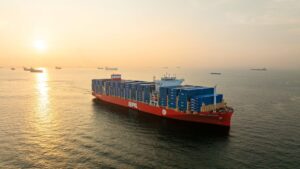The container shipping’s bet on LNG amid geopolitical turbulence

As global shipping navigates the treacherous waters between decarbonization mandates and geopolitical upheaval, liquefied natural gas has emerged as the container industry’s fuel of choice a pragmatic wager that’s reshaping maritime energy politics.
LNG-fueled container vessels are positioned for continued expansion despite regulatory uncertainty, driven by practical advantages over methanol and immediate decarbonization benefits.
However, this growth trajectory intersects with escalating geopolitical tensions around energy security, trade protectionism, and shipping infrastructure vulnerabilities.
LNG-fueled container ship orders nearly doubled from 194 vessels in late 2023 to 362 by mid-October 2025, even as overall alternative-fuel orders dropped to just 52% of the previous year’s levels.
Container vessels now command 65% of all alternative-fuel orders, with dual-fuel configurations dominating 79% of the current orderbook.
Container operators are betting on LNG’s practical advantages over competitors like methanol, which remains constrained by limited supply and stubbornly high prices.
LNG delivers immediate benefits: a 20% reduction in carbon emissions, widespread infrastructure availability, and operational flexibility that proves invaluable when trade routes shift unexpectedly.
The Ukraine war accelerated what climate policy alone couldn’t achieve. Desperate to replace Russian pipeline gas, Europe built seven new LNG terminals in the Baltic region between October 2022 and March 2024. Germany alone commissioned five facilities a breakneck pace enabled by emergency legislation that swept aside normal bureaucratic procedures.
This infrastructure boom creates a virtuous cycle for maritime LNG adoption. As terminals proliferate, bunkering becomes easier. As more ships burn LNG, terminal economics improve. The container industry finds itself riding a wave of geopolitical necessity disguised as energy transition.
Yet this transition unfolds against deepening US-China antagonism that threatens to reshape global shipbuilding.
China controls 53.3% of global shipbuilding capacity while the US limps along at 0.1%. Chinese yards lead in constructing LNG-capable vessels, but Washington’s proposed docking fees targeting Chinese-built ships introduce a costly dilemma for carriers.
The Red Sea crisis exposes how regional instability can upend even the best-laid plans.
Houthi attacks forced container ships to reroute around Africa’s Cape of Good Hope, adding 70% to journey lengths and fuel consumption. For LNG vessels, this means burning more gas to achieve the same emissions reductions a reminder that geopolitics can erase technical advantages overnight.
The disruption also highlights dual-fuel vessels’ strategic value. When routes lengthen unexpectedly or fuel prices spike, the ability to switch between LNG and conventional bunkers becomes a critical hedge against uncertainty.
The market’s trajectory depends on which forces dominate.
If the IMO delivers regulatory clarity by October 2026, orders could surge past 500 vessels. But protectionist escalation could choke supply, stalling growth around 380-400 vessels as Western yards struggle to fill the gap.
A prolonged Red Sea crisis validates dual-fuel flexibility but strains LNG supply chains.
Chinese economic weakness might slow orders while maintaining long-term momentum. Most likely, extreme energy price volatility driven by multiple conflicts will accelerate adoption as operators prize fuel-switching capability above all else.
LNG-fueled container vessels represent more than a technical fix for carbon emissions. They’ve become strategic assets in a fragmenting global order, where energy security, trade tensions, and maritime chokepoints intersect with climate imperatives.
The International Maritime Organization’s delayed Net-Zero Framework symbolizes this complexity industry momentum for decarbonization persists despite regulatory uncertainty, driven by commercial logic and geopolitical necessity rather than policy mandates alone.
What emerges is a shipping sector navigating by multiple stars: environmental targets, fuel economics, infrastructure availability, and the hard realities of a world where trade routes can become battlegrounds overnight.
In this environment, LNG’s dominance reflects not perfection but pragmatism a transitional solution for transitional times, when the destination remains clear even as the path keeps shifting.
The container industry’s LNG bet will likely pay off, but not quite as planned.
/ihc-hide-content]
The post The container shipping’s bet on LNG amid geopolitical turbulence appeared first on Container News.
Content Original Link:
" target="_blank">

































































